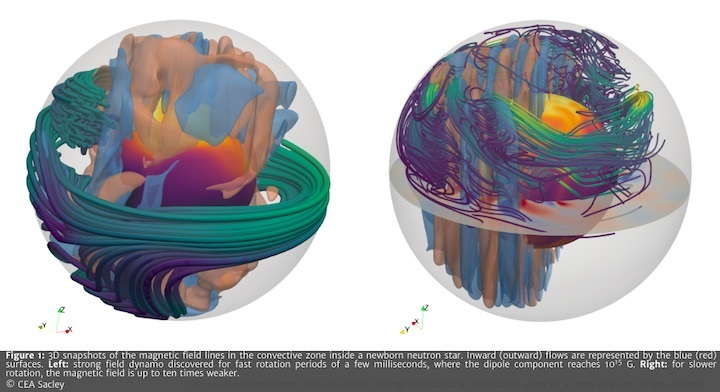16.03.2020

Magnetars are neutron stars endowed with the strongest magnetic fields observed in the Universe, but their origin remains controversial. In a study published in Science Advances, a team of scientists from CEA, Saclay, the Max Planck Institute for Astrophysics (MPA), and the Institut de Physique du Globe de Paris developed a new and unprecedentedly detailed computer model that can explain the genesis of these gigantic fields through the amplification of pre-existing weak fields when rapidly rotating neutron stars are born in collapsing massive stars. The work opens new avenues to understand the most powerful and most luminous explosions of such stars.
Magnetars: what are they?
Neutron stars are compact objects containing one to two solar masses within a radius of about 12 kilometers. Among them, magnetars are characterized by eruptive emission of X-rays and gamma rays. The energy associated with these bursts of intense radiation is probably related to ultra-strong magnetic fields. Magnetars should thus spin down faster than other neutron stars due to enhanced magnetic braking, and measurements of their rotation period evolution have confirmed this scenario. We thus infer that magnetars have a dipole magnetic field of the order of 1015 Gauss (G), i.e. up to 1000 times stronger than typical neutron stars! While the existence of these tremendous magnetic fields is now well established, their origin remains controversial.
How do they form?
Neutron stars generally form after the collapse of the iron core of a massive star of more than nine solar masses, while the outer layers of the star are expelled into interstellar space in a gigantic explosion called a core-collapse supernova. Some theories therefore assume that neutron star and magnetar magnetic fields could be inherited from their progenitor stars, which means that the fields could be entirely determined by the magnetization of the iron core before collapse. The problem with this hypothesis is, however, that very strong magnetic fields in the stars could decelerate the rotation of the stellar core so that the neutron stars from such magnetized stars would rotate only slowly.
“This would not allow us to explain the huge energies of hypernova explosions and long-duration gamma-ray bursts, where rapidly rotating neutron stars or rapidly spinning black holes are considered as the central sources of the enormous energies,” remarks team member H.-Thomas Janka of MPA. Therefore, an alternative mechanism appears more favorable, in which the extreme magnetic fields could be generated during the formation of the neutron star itself.
In the first few seconds following stellar core collapse, the newborn hot neutron star cools down by emitting neutrinos. This cooling triggers strong internal convective mass flows, similar to the bubbling of boiling water in a pot on a stove. Such violent motions of the stellar matter could lead to the enhancement of any pre-existing weak magnetic field. Known as the dynamo effect, this field-amplification mechanism is at work, for instance, in the liquid iron core of the Earth or in the convective envelope of the Sun.
To test such a possibility for neutron stars, the team of researchers used a supercomputer of the French National Computing Center for Higher Education to simulate the convection in a newborn, very hot and rapidly spinning neutron star. Indeed, they found by this new modeling approach, which was more detailed than any other treatment used before, that the weak initial magnetic fields can be amplified up to values reaching 1016 G for sufficiently fast rotation periods (see Fig. 1).
“Our models demonstrate that spin periods shorter than about 8 milliseconds allow for a more efficient dynamo process than slower rotation,” says Raphaël Raynaud of CEA, Saclay, the lead author of the publication. “Slower rotating models do not display the enormous fields created by this strong dynamo.”
Biggest cosmic bombs?
In addition to shedding light on Galactic magnetar formation, these results open new avenues to understand the most powerful and most luminous explosions of massive stars. For instance, superluminous supernovae emit a hundred times more light than usual supernovae, while others, called hypernovae, are characterized by a kinetic energy larger by a factor of ten and sometimes associated with a gamma-ray burst lasting several tens of seconds. These outstanding explosions constrain us to imagine non-standard processes that must extract tremendous amounts of energy from a "central engine".
The "millisecond magnetar" scenario is currently one of the most promising models for the central engine of such extreme events. It considers the rotational energy of a fast rotating neutron star as the additional energy reservoir that increases the power of the explosion. By exerting a braking torque, a strong dipole magnetic field of 1015 G can transfer the neutron star’s rotational energy to the explosion. “For this mechanism to be efficient, the field strength must be of the order of 1015 G,” explains coauthor Jérôme Guilet of CEA, Saclay. “This closely matches the values reached by convective dynamos for millisecond rotation periods” (see Fig. 2).
Until now, the main weakness of the millisecond magnetar scenario was to assume an ad hoc magnetic field, independent of the fast rotation rate of the neutron star. The results obtained by the research team thus provide theoretical support that was missing to this central engine scenario powering the strongest explosions observed in the Universe.
Quelle: MAX-PLANCK-GESELLSCHAFT
